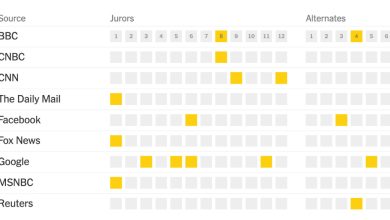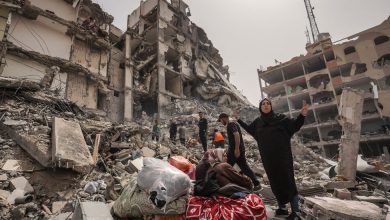As a Crisis Hotline Grows, So Do Fears It Won’t Be Ready

The National Suicide Prevention Lifeline — the number posted on student identification cards, atop Google search results and in warning labels on television shows — is about to get a major reboot, casting it as the 911 for mental health.
With an infusion of federal money, the upgraded Lifeline starting in July will have its own three-digit number, 988, and operators who will not only counsel callers but eventually be equipped to dispatch specially trained responders. That will reduce interventions by armed law enforcement and reliance on emergency rooms — and ultimately keep people alive, advocates say.
But there are growing concerns that the 24-hour hotline, already straining to meet demand, will not be able to deliver on the promises of the overhaul unless states supplement the federal money with significant funds for staffing, according to interviews and government reports.
Right now, the crisis line is answered by a patchwork national network of more than 180 call centers, often nonprofits, that juggle several hotlines and rely on both paid counselors and volunteers. A majority of centers run on shoestring budgets, with little or no backing from states; many do not have funding specifically for answering Lifeline calls, according to a survey. Some use golf outings, benefit breakfasts and other fund-raisers to help pay the bills.
But after the number changes to 988 — a shift that involves upgrading telecom infrastructure and bringing more call centers online — use of the hotline is expected to grow exponentially over the next few years. (The current number is 800-273-8255.)
Already, of the approximately two million phone calls to the Lifeline last year, about 330,000 — roughly 17 percent — were abandoned before a caller could get help, according to a New York Times data analysis. The texting and online chat lines, which together fielded another million contacts last year, lagged further behind, not attending to 41 percent of texts and 73 percent of chats. Calls and messages are abandoned for any number of reasons, but in interviews, callers blamed hold times and call center directors bemoaned limited capacity.
The only call center in South Carolina, for instance, until recently operated out of an old, dark basement, near a boiler room. The last remaining one in Louisiana has struggled to keep up with an influx of calls after another center closed and its replacement went offline during the pandemic. Minnesota and Wyoming have had periods with no centers at all. When local centers cannot pick up, calls are pushed to national backup centers, where counselors are less likely to be familiar with local resources and wait times can be too long for people in crisis.
“We can’t help them if they don’t connect with our service,” said Dr. John Draper, the executive director of the Lifeline and an executive with Vibrant Emotional Health, a New York-based nonprofit, which manages the Lifeline for the Substance Abuse and Mental Health Services Administration.
The changes at the Lifeline come at a time of growing mental health concerns exacerbated by the pandemic, including what the U.S. surgeon general has warned is a crisis among young people. Suicides in the United States have increased over the past two decades to about 45,000 a year.
The rising toll underscores the need to both quickly fix the fractures within the existing Lifeline and build out its capacities, mental health advocates say, so it can be available to support people like Valerie, a 24-year-old in Burlington, N.C. (She requested that her last name be withheld for privacy.)
As a teenager, she made dozens of late-night calls to theLifeline. A volunteer named Chris, who worked the late shift, usually would pick up and talk her to safety. But during the last several years, she has found it increasingly difficult to reach a counselor. Several times, she said, she hung up and harmed herself.
“If you are in a crisis, you need help immediately,” she said in an interview.
Others described similar experiences. A woman from Michigan, who said she waited twice for over an hour before hanging up, likened the experiences to calling airline customer service — except that she was seeking suggestions on “not killing myself.” A teenager from Mississippi recounted calling three times one night without getting through, and then overdosing.
“They have every right to expect that the system is available to them, and we know that it’s going to take time to build upon what was really a system that was under-resourced and quite fragmented,” said Dr. John Palmieri, who is leading the Substance Abuse and Mental Health Services Administration’s 988 rollout efforts.
In a December report to Congress, not previously made public, the agency called the system “understaffed,” saying it had “not grown quickly enough to keep pace with existing demand.”
“There are thousands of users — many of whom may be in suicidal crisis — who seek assistance and are unable to get the lifesaving help they deserve,” the report said.
An estimated 4 percent of Lifeline callers are believed to be at imminent risk or actively attempting suicide, according to another recent government report, while another 23 percent have hadsuicidal thoughts within 24 hours of calling.Many are repeat callers — and, data shows, call centers can resolve about 80 percent of crises without further intervention, like sending the police.
When the Lifeline can pick up — when it works as intended — it is effective, researchers say, because it gives people someone to talk to in their darkest moments. “That can make the difference between someone being alive and not alive,” said Madelyn Gould, a psychiatric epidemiologist at Columbia University.
Her assessment matches feedback that many callers shared on social media.One said a counselor had talked her “off the ledge.” Another wrote, “This line has saved my life on multiple occasions, including tonight.”
‘Lean, Clean, Working Machine’
Within a few years of the introduction of 988, the Lifeline is likely to attract tens of millions of people seeking help, estimates show. Those projections are drivingmental health advocates as they prod state lawmakers to approve funding.
“Our concern is very much about whether there will be someone to answer that call when someone is in crisis,” said Hannah Wesolowski, chief advocacy officer for the National Alliance on Mental Illness.
In December, the Biden administration authorized a one-time influx of $282 million to upgrade infrastructure and fortify call centers, bringing many more online. The Lifeline’s central operations have historically been underwritten each year by the federal government, most recently receiving $24 million in 2021. Each of the call centers, which can cost millions of dollars a year to staff, gets an annual federal stipend of $2,500 to $5,000, as well as an occasional larger grant, but they are mainly on their own to source funding.
The law establishing 988 — signed by President Donald J. Trump in October 2020 with bipartisan support — gave state lawmakers the option of raising money for call centers the same way they do for 911: with a monthly fee on phone bills. These fees collect an estimated $3 billion annually for 911, helping to ensure ongoing funding.
For 988, such fees could also help pay for mobile response teams that can be dispatched to people in crisis, as well as for specialized triage centers — both significant, and costly, elements of what advocates see as a watershed opportunity to recast the delivery of mental health care.

Kabrea James, a counselor at First Choice Services in Charleston, W.Va. Call centers can resolve about 80 percent of crises without further intervention, like sending the police.Credit…Mark Trent for The New York Times
Paying for 988, and what comes with it, has emerged as a contentious issue for states. Some lawmakers are wary of adding what they see as a new tax. Others think 988 is redundant with other resources. And telecommunications lobbyists, while broadly supportive of 988, have pushed back on some proposed fees.
Only four states have authorized a phone-bill charge for 988, according to groups tracking statehouse deliberations. At least a dozen other states have pending legislation related to the 988 rollout, with some looking to tap general funds or Medicaid money to pay for it. Some states have approved studies or other approaches, but many have made no discernible movement on funding.
As lawmakers in Kansas debated a bill last month that would add a 20-cent monthly fee on all phone bills, John Barker, a Republican state representative, said he supported 988, but the fee would be burdensome for poor residents. “It is just like the United States Congress, though, to send us something like this” — with instructions that “you are going to fund it,” he said.
Representative Tony Cárdenas, a Democrat from California and a main congressional proponent of 988, said the reimagined Lifeline would reduce costs by limiting police interventions in mental health emergencies. “With all due respect, 988 is going to save the taxpayers a whole lot of money,” he said.
Xavier Becerra, secretary of the Department of Health and Human Services, has been on a national speaking tour about mental health and talking with governors about 988, who he said had been receptive. The goal, he said, is to replace the current system with a “lean, clean, working machine so that we can get this done for the people that call in.”
Answering the Phone
Jennifer Battle, who runs a Houston call center that answers the Lifeline, worked on the original plans for 988, thinking that it would be an “amazing” upgrade. But she has grown concerned as ambitions expanded to include emergency workers and mental health triage centers — all as the state-by-state funding has fallen short.
“The crisis centers are like, ‘You don’t get any of those other things if people aren’t here to answer the phone,’” said Ms. Battle, director of access at the Harris Center, which provides services for mental health issues and developmental disabilities.
When the Lifeline began in 2005, its calls were routed to pre-existing call centers, many of which added it to their roster of numbers despite the lack of funding because it aligned with their mission.
Over time, call volume swelled, but funding did not keep up. Incoming calls have nearly doubled since 2016; the portion of abandoned ones has remained around 17 percent, data shows. The Lifeline said 80 percent of callers who disconnected did so within two minutes of the automated greeting, and about a quarter of those who hung up tried again within 24 hours and got through. (The data excludes calls received from U.S. territories, as well as those routed to the veterans and Spanish-language lines.)
One goal of 988 is to eventually answer 95 percent of all incoming calls within 20 seconds. The data analysis showed that only two states had Lifeline answer rates above 95 percent in the fourth quarter of last year. Thirty-three states had more than 15 percent of their calls abandoned.
“I don’t think it is acceptable,” said Justin Chase, chief executive of Solari Crisis and Human Services, based in Arizona, a state where 93 percent of calls are answered. “People call in their most dire state of need.”
As part of the 988 rollout, new federal grants are allowing centers to hire more counselors, although those efforts have been hampered by a nationwide worker shortage. Backup centers are also getting a major boost, with new funding to build capacity.
West Virginia’s lone call center answering the Lifeline, First Choice Services, also answers more than 15 other numbers, including ones for gambling, tobacco and drug and alcohol addiction, most with volume rising during the pandemic. Still, Lata Menon, the center’s chief executive, said her organization has kept up. And though 988 will come with new responsibilities — the center, for example, does not yet field chats or texts — there are indications that more funding is coming.
“We have a very real fear that without funding our program in a substantial way,” she said, “our West Virginia callers will suddenly be facing what has been a problem nationally.”
For additional suicide prevention resources in the United States, go to SpeakingOfSuicide.com/resources. Go here for resources outside the United States.




